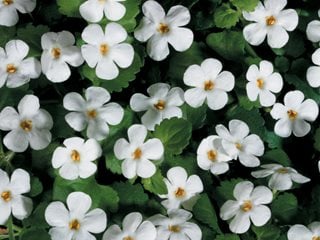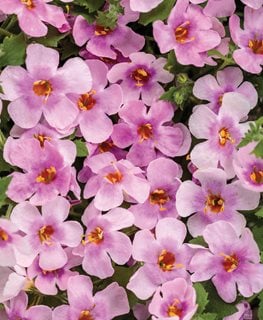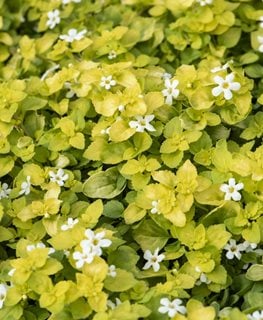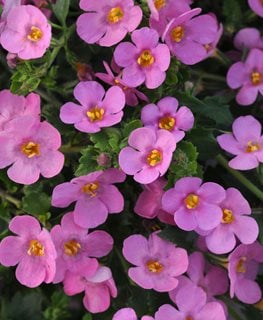Bacopa - How to Grow and Care for Bacopa Plants
Add this trailing annual to your summer landscape for easy-care colorThe delicate pastel flowers and finely textured foliage of bacopa plants belie its tough nature. Most often grown as an annual, this blooming workhorse provides summer-long color with very little effort. Whether used as a cascading accent in a hanging basket or a sprawling ground cover in the landscape, bacopa combines well with other plants and is virtually carefree, making it a versatile choice for home gardeners.
On this page: The Basics | Planting Tips | Bacopa Care | Pictures | Design Ideas
THE BASICS

Snowstorm® Giant Snowflake® bacopa. (Sutera cordata).
Photo by Proven Winners.
Zones:
Generally grown as an annual, but may overwinter in Zones 9-11
Height/spread:
Mounding trailing habit, 3 to 12 inches tall, 10 to 36 inches wide
Exposure:
Full sun to partial shade; bloom is most prolific in full sun
Bloom time:
From the time of planting until frost. Bacopa is sensitive to extreme heat and may not bloom as well during the hottest part of summer. Newer varieties are bred for heat resistance.
Color and characteristics:
Dainty dime-sized flowers have a yellow eye, with petals in pastel hues of white, pink, blue, or lavender. Small leaves are rounded with toothed margins, occurring in colors of green, gold, or variegation.
Deer resistance:
Deer will leave bacopa alone for the most part, though extreme conditions can result in deer grazing on plants they wouldn’t otherwise.
PLANTING TIPS
When to plant:
Plant outside in mid-late spring after all danger of frost is past.
Where to plant:
Bacopa plants grow in a sunny to lightly shaded site. Plants will flower best in full sun.
How to plant:
For beds and borders, loosen soil in the planting site, work in soil amendments and space plants 10 to 12 inches apart. For containers, plants can be spaced slightly closer together.
BACOPA CARE
Maintenance:
Flowers are self-cleaning; no deadheading is necessary. Plants can be lightly pruned to size if they become overgrown.
Soil:
For beds and borders, amend soil with compost or other rich organic matter and provide good drainage. Optimal soil pH is 5.6 to 5.9. For containers, use a high quality all-purpose potting soil that drains well.
Watering:
Keep plants evenly moist, but don’t overwater. Unlike most plants, bacopa doesn’t wilt when drought-stressed; instead, the flowers and buds will drop off. It takes a couple of weeks for plants to recover and set new buds. TIP: Place with another plant that does wilt such as coleus, verbena, or petunia, which will serve as an indicator to show when the soil is too dry.
Amendments and fertilizer:
Apply a balanced water-soluble fertilizer according to package instructions every 2 to 3 weeks for landscape plants, or every 1 to 2 weeks for containers.
Diseases and pests:
When grown in the right conditions, bacopa experiences few problems. Possible pests include aphids, spider mites, whiteflies, or thrips. Botrytis, powdery mildew, root or stem rot can occur from overwatering or poor drainage.
VARIETIES OF BACOPA
DESIGN IDEAS

Brooklyn Heights container recipe. Photo by Proven Winners.
How to use:
Bacopa is best used as “spiller” element in a container, or as a spreading groundcover in the landscape. Use as pathway edging, in mass plantings, hanging baskets, window boxes, and upright containers.
Pair with silver:
The pastel shades of bacopa flowers combine well with silver-foliaged plants. Place alongside lamb’s ears, dusty miller, Helichrysum ‘Silver Mist’ or ‘Silver Mound’ artemisia for an elegant touch.
Pastel-themed containers:
For a pastel-themed basket, try this Brooklyn Heights recipe (pictured).
Color that packs a punch:
For a brighter look, try this Best Friend recipe.
More container ideas:
See more bacopa container recipes.
Companion plants:
Bacopa combines well with many other annuals. When making your own customized containers, use the principle of “thriller, filler, spiller” with the bacopa acting as a spiller element. Companion plants include:
- Petunia
- Calibrachoa
- Verbena
- Begonia
- Coleus
- Angelonia
- Nemesia
- Dusty miller
- Lantana
- Geranium
- Purple fountain grass
- Lobelia
RELATED:
Annual Flowers
Annual Flowers to Consider for Your Garden This Year
Building Container Combos








